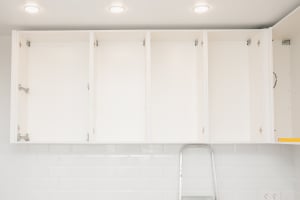Painting residential interior wood doors is a simple way to achieve a new look or match high-quality doors to your unique design scheme without needing to replace them altogether. Of course, if your current doors are worn, tired, or uneven, it might be worth considering a premium upgrade that will last for years, with popular finishes including smooth, velvety walnut, bright modern bleached oak, and intricate zebra wood veneers.
Can you buy interior doors with pre-cut hinges to replace damaged doors faster? Absolutely–we can also dispatch internal doors complete with all the fixings, framing, and accessories to complete the aesthetic you aspire to.
How Easy Is It to Repaint an Interior Door?
The painting itself is relatively straightforward, but the key is in preparation, ensuring you achieve the right finish, with doors that look elegant, professionally decorated, and without any bubbles, gaps, or colors showing through thin layers of paint. You’ll also find guides covering topics such as how to install interior double doors in existing opening spaces within our knowledge library.
The right steps will depend on the surface already used on the door:
- The current paintwork may have to be stripped back to prevent it from warping or causing the new paint to slide.
- Wooden doors will need sanding and priming to guarantee good adherence between the paint and timber.
- Doors coated with a varnish or stain will also need to be primed or treated depending on the type of paint you wish to use.
It's wise to spend plenty of time on painting prep and removing locksets and accessories from the door; this is significantly quicker than covering all fixtures with masking tape and potentially needing to remove rogue drips. You can leave doors hung as you paint (covering both sides), but you should put a floor covering underneath and wear protective clothing. Even the most careful painter may find thinner paints, such as gloss, can run, splash, and drip.
How to Paint an Interior Door Step-by-Step
Before you begin, gather all the tools and items you’ll need for the painting project. That should include:
- Sandpaper
- A screwdriver
- Masking tape
- Your chosen primer and paint
- Sandpaper or dust sheets
- Brushes or a roller
As we've indicated, preparation is essential for a good finish, so vacuuming around the area to remove dust and cleaning surfaces and the door itself will eliminate dust particles from settling into wet paint. This is also a good time to lay down dust sheets, newspapers, and coverings to protect your flooring and furniture.
Preparing an Interior Door for Repainting
Prepping the surface will vary with different finishes but will mean either sanding the door, stripping old paint, or adding a primer. The aim is to achieve a smooth, even, and clean surface ready for painting.
Remove the handles and hardware at this point and keep them to one side, with all the screws and components, to ensure they are easy to reattach once your painting project has finished. Adding masking tape over the hinges will protect them from paint, and you may wish to mask around the edges of the door frame if you intend to paint the frame as well as the door.
How to Paint a Door to Achieve a Perfect Finish
Begin painting from the edges, working inward, concentrating on even, smooth brushstrokes. Some brushes can shed bristles, which you can remove by hand or with tweezers as you go.
Flat doors may be faster to paint with a roller or a wide brush, although applying thick layers of paint will result in marks and smudging. Doors with panels and other decorative features are easier to paint with a brush.
How Long Does It Take for Paint to Dry on an Interior Door?
Coat one should have four to six hours to dry thoroughly before adding a second layer. When the paint is cured and doesn’t show a fingerprint when pressed, you can start using the same paint application method on your second coat.
Finally, you can remove the dust sheets and masking tape when the painting is finished. It's advisable to allow twenty-four hours or more for the paint to be completely dried before attaching the handles and other hardware.
Be cautious of touching the door before this time. Although it might feel dry to the touch, layers of freshly applied paint will remain spongy and wet underneath; opening windows to improve ventilation will aid in faster drying times.













